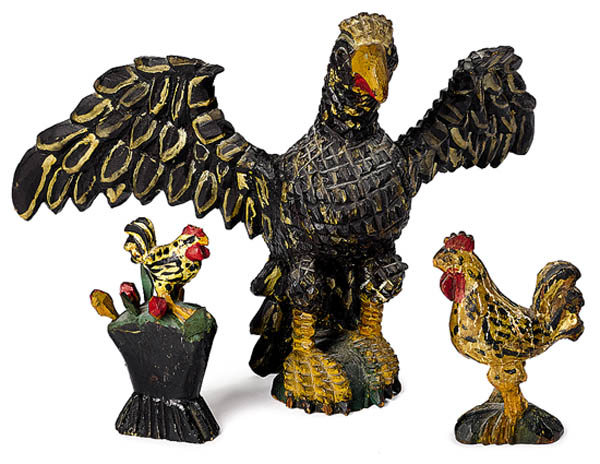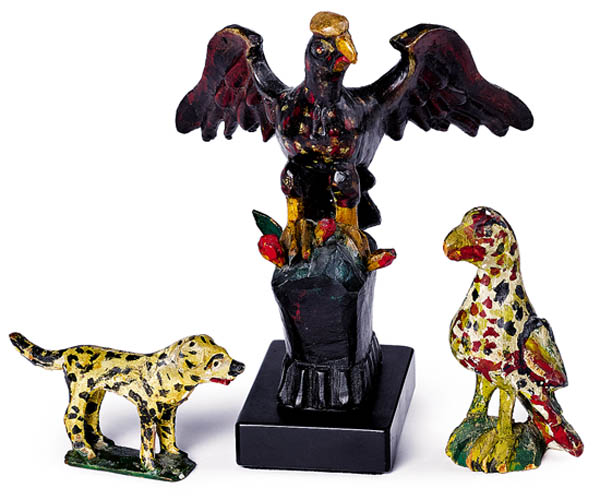The Eagle Has Landed
Seven Attributed Schimmel Carvings To Be Sold At Pook & Pook
By Cynthia Beech Lawrence - September 10, 2021
The upcoming Americana and International Sale on Sept. 30 and Oct. 1 at Pook & Pook features seven works attributed to Cumberland County, Pa., folk artist Wilhelm Schimmel (1817-1890). To collectors of American folk art, this will not come as a surprise. Pook & Pook has sold many Schimmel carvings over the years. Karl Pass, former curator at the Cumberland County Historical Society, current editor of Antiques & Auction News, completed his Masters Thesis on the subject of Schimmel. In a period of roughly 21 years (1869-1890) there were never longtime periods, given period newspaper reports/arrest reports, he gravitated far from the town of Carlisle. It is not difficult to estimate his output at 1,000 to 1,500 carvings, of which around 500 attributed pieces exist today, said Pass. Based on those figures, Pook & Pook has sold roughly 15 percent of all Schimmels attributed works. Of the nearly 100 Schimmel eagle carvings that survive, about 40 percent have crossed the auction block at Pook & Pook since the 1980s. An Odd Bird Old Schimmel the German who for many years tramped through this and adjoining counties making his headquarters in jails and almshouses, died at the almshouse on Sunday. His only occupation was carving heads of animals out of soft pine wood. These he would sell for a few pennies each. He was apparently a man of very surly disposition, read the Carlisle Evening Sentinel, Aug. 7, 1890. It is unknown when Schimmel arrived in the country. An 1870 census puts him in the county prison, born in Hesse-Darmstadt, Germany. He did not speak English. By todays terms, a serial alcoholic, many colorful period newspaper accounts exist, the earliest being 1869, when, roaring drunk and plastered in mud, he trashed the office of a lumberyard. Upon being ejected, he hurled rocks into the yard until overcome by return volley fire and escorted to jail. In 1879, a drunk Schimmel at a public sale attacked a man with an axe. His victim managed to hit him over the head with a stone, sending him unconscious. One paper reported he had died of the incident, and he nearly did, but recovered. In 1882, Schimmels addiction came close to finishing the job when he stepped off a train moving at near full speed a mile short of the Plainfield station. The conductor retrieved him, placing him into a baggage car and transported him to the county almshouse. This incident required a month for head and eye injuries. Adventures in Babysitting According to the late Milton Flower, who collected oral histories in the 1940s, Schimmel roamed the Cumberland Valley along the Conodoguinet Creek between the farms of German-speaking families. He would sleep in outbuildings and barns in exchange for carvings or doing chores. Many of the carvings he exchanged were gifts and toys for children, perhaps inspired by their own animals. Roosters of various size were his most prolific subject. In Flowers era, many historians treated oral tradition and local legend as scholarship and didnt use and cite primary source material, furthered Pass. This is evident in the story his fogels (eagles) lined the shelves behind local bars. Until a period photo or reliable newspaper account surfaces, this is just a tale. Same goes for Flowers story of Schimmel becoming irate for not winning a prize at the county fair. I found on microfilm an 1883 account of Schimmel actually receiving an award of honorable mention in the bric-a-brac category at that years fair. Wouldnt it be great to see a photo of that display! stated Pass. Eagle Eyed Whatever crucible of substance abuse, penury, or echoes from his past life pushed him to the fringes of society, unable to communicate with most people, Schimmel did have a direct connection to his creations, which he never signed. It didnt matter that his blasted body had dossed beneath a bridge overnight, or that his brain hallucinated in the grip of withdrawal, his hands and his instinct could feel the creation within each piece of wood, ready to emerge. Schimmel carved mostly birds and animals, such as roosters, parrots (eaglets), squirrels, and dogs, and, of course, his eagles. Patriotic fervor around the 1876 Centennial resulted in great pride of the eagle. We know there are accounts of Schimmels eagles adorning a flag pole, portico roof, and fence post, said Pass. Milton Flower noted the influence of the Hapsburg eagle on the style of Schimmels carvings. His are not conventional late 19th-century depictions of our national symbol; they are unique to Schimmel. Carved from pine, the eagles are either smooth or covered in saw-toothed crosshatching. The resulting diamond pattern from hatching creates the effect of puffed feathers, the unevenness of the cuts hinting at the motion of muscles below. The spread wings were dovetailed into the body and covered with detailed feathering cuts. The figures were then gessoed and painted. Observing the eagles from different angles, their eyes stay trained upon you, just like those of real eagles, whose range is 300 degrees. In spite of their fierce demeanor, Schimmels eagles meet your gaze with a soulful tilt of the head. It is not unlike being sized up by a domestic bird. The result, the solid shape of the eagle bodies, the drama of their beating wings and arched necks, ready beaks and bright eyes, are life itself, wrought from wood. To hold one of these eagles in your hands is to feel its vitality, as though with a burst of energy and a spontaneous shrug it might escape your grasp. The Folk Artist Today, Wilhelm Schimmel is revered as the creator of American folk art. In the 1920s, a surging interest in the subject propelled this itinerant carvers work to a level of national recognition, about 30 years following his death. Schimmels carvings were sought by early collectors like Abby Aldrich Rockefeller, Henry Francis DuPont, and Elie Nadelman. According to Pass, dealers acquired Schimmels through canvassing the valley as early as the 20s and 30s and buying carvings from mostly second and third generation original owners. These were in and around such places as Plainfield, Huntsdale, Newville, and Newburg. In 1965, Abby Aldrich Rockefeller Folk Art Museum at Colonial Williamsburg held the first major exhibition of Schimmels work. Since then, noteably around the Bicentennial in 1976, recognition of Schimmels work has grown, and the value of his pieces, eagles in particular, ha soared. Birds of a Feather On Sept. 30 and Oct. 1, Pook & Pook will offer seven attributed works by Wilhelm Schimmel (six pictured). Leading the jubilee is a carved spread-winged eagle, retaining its original paint, measuring 9 inches high with a 12.25 inch wingspan, estimated at $12,000-$18,000. Flying close behind is another carved spread-winged eagle on a perch, retaining its original paint, measuring 7.75 inches high, estimated at $8,000-$12,000. Other Schimmel lots include an eaglet, three roosters, and a white and black spotted dog, all retaining their original paint. Sources Pass, Karl H., Wilhelm Schimmel: Cumberland County Image Maker (1817-1890), Cumberland County History, Winter 2002, Vol.19, No.2. Flower, Milton E., Three Cumberland County Wood Carvers, Cumberland County Historical Society, Carlisle, PA, 1986. Flower, Milton E., Wilhelm Schimmel & Aaron Mountz Wood Carvers, Abby Aldrich Rockefeller Folk Art Collection, exhibit Sept. 4 Oct. 31, 1965, Williamsburg, VA.



SHARE
PRINT